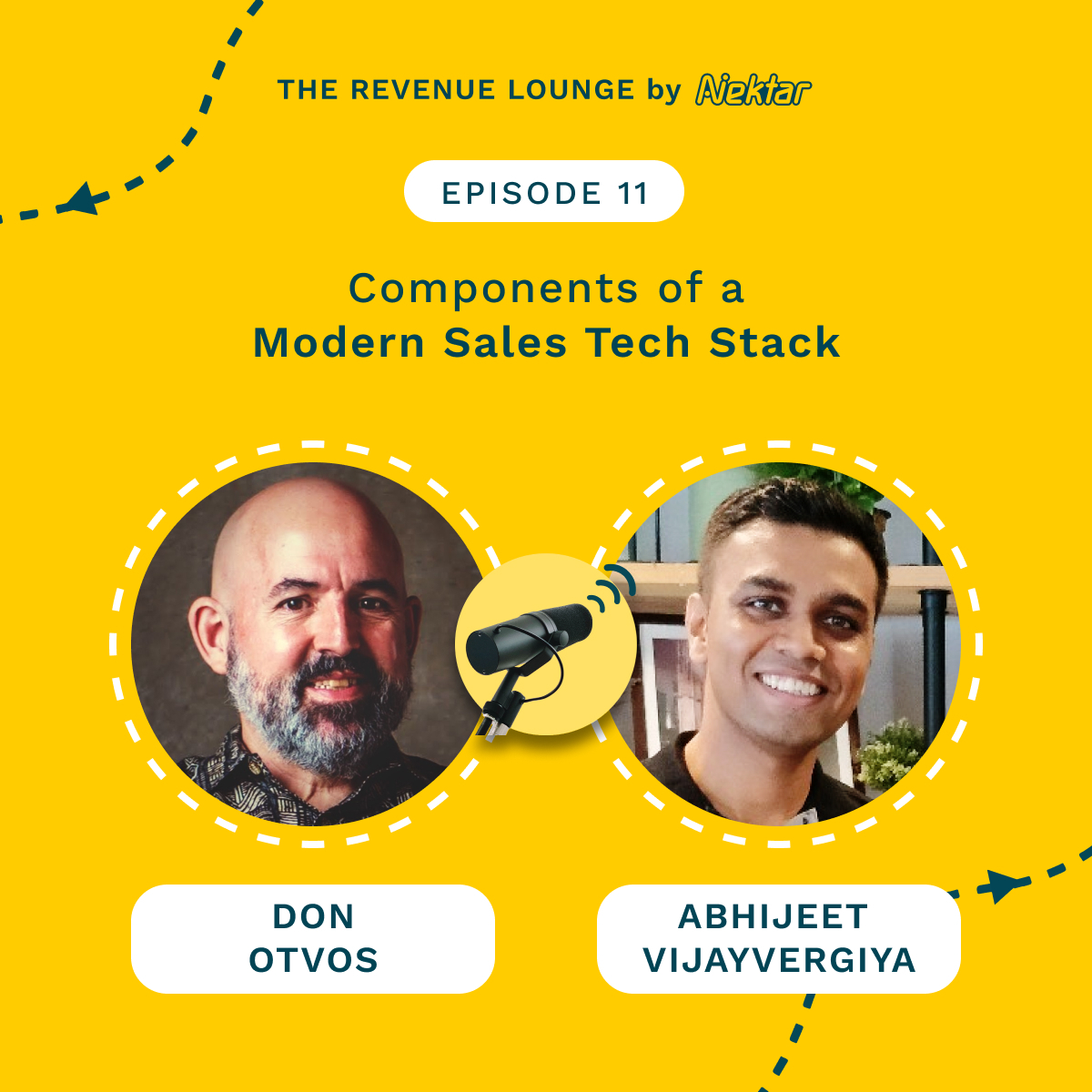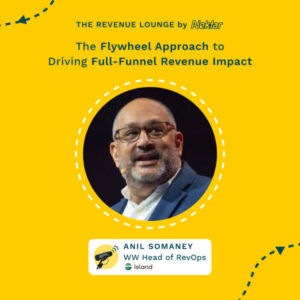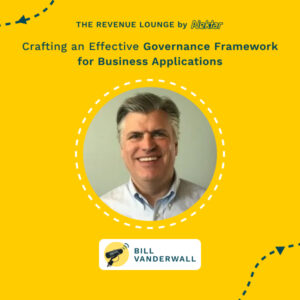Ep #7: Orchestrating Siloed Data to Drive Business Decisions
October 26, 2022
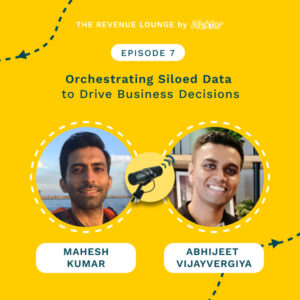
About
The Revenue Lounge
The podcast covers stories from leaders across RevOps, Sales, Customer Success, GTM, Data and Marketing about what drives these functions and what advice they would share with our listeners. With 3 seasons recorded, the podcast currently features 50+ enterprise leaders in the B2B SaaS domain. Tune in to hear from the best in the business
Data inefficiencies continue to plague organizations. Inaccurate, stale and missing data have made companies lose as high as 30% of their annual revenue.
Clean, reliable and trustworthy data is the key to making GTM efforts successful. And having a single source of truth for data to keep all cross-departments aligned on similar revenue goals is key to making revenue operations a successful function.
But how can RevOps teams carry out this critical data orchestration?
We have Mahesh Kumar, Senior RevOps leader at AppViewX to guide us through this topic. Mahesh is one of the top leaders in the Revenue operations space and has helped several RevOps teams break data silos and run predictable and repeatable revenue engines.
Let’s hear it from him!
Want to learn more about Nektar?
Talk to our team – https://bit.ly/3MDa52H

[00:00:00] Hello and welcome to the latest episode of The Revenue Lounge. Our guest today is Mahesh Kumar. He’s the Senior Director of Revenue Operations at AppViewX. Mahesh is counted amongst the top 25 RevOps leaders of 2022. He has 11 years of experience in high growth, dynamic sales and marketing environments.
[00:00:18] We’re delighted to have you today on The Revenue Lounge, and thanks for spending time with us today. Very excited with the conversation.
Thank you, Abhijeet. It was definitely a pleasure meeting you and thanks for your invite.
Yeah, looking forward to learning more from your experience. So let’s jump straight into our conversation.
[00:00:36] So my first question is just about your introduction. If you can tell a little bit about your current role at AppViewX, let’s get started with that.
Sure. So in my current role, my team and I spend predominantly, the idea is to provide strategic value by optimizing the go to market functions, right?
[00:00:58] So it’s sales, marketing, and customer success. The ultimate goal is to make sure we improve the lead to revenue and retention funnel. And personally, I spend lot of time on uncovering insights from the data points we collect throughout the revenue funnel and, uh, feed those back to the corporate strategy and business.
[00:01:23] Yeah, that’s, that’s phenomenal. I mean, you are basically the unsung hero there who is helping the GTM engine drive those dollars. So very excited to hear how the data part plays out. Um, so before we move on to the nitty integrities of what you do here, it’d be good to get your understanding of revenue operations.
[00:01:40] Cause there’s one question that I ask everyone because there’s so many different versions of revenue operations that goes around. So would be interesting to hear your perspective on what, what do you define as. . Yeah, that’s, uh, definitely very common and, uh, interesting question. The way how I look at [00:02:00] revenue operations to kind of remove the art part of the revenue engine and bring science to it.
[00:02:07] So it’s like, make the revenue engine a science oriented engine, right? Like remove the gut feel hunches and, and the art part of it. So that’s the ultimate. Uh, that’s how I define revenue operations. And for that to happen, yeah, definitely we need to get the process aspect, technology aspect and, and the data aspect accurate and put it together.
[00:02:32] But the key is to uncover the, the hidden insights, right? Like when, when we put all these pieces together, there are lots of signals and insights. The key is to uncover these insights and feed it. , that’s when rev ops becomes a game changer and, and, and drives growth. Yeah, I think you’re right. So moving from tactical to strategic, right?
[00:02:56] I think a lot of rev op people have become very good [00:03:00] HandsOn operators dealing with lot of data issues, reporting requirements, system implementations, training, onboarding as well in some cases. But I think what you’re probably emphasizing is evolution of rev ops into a. Profit Center for the organization, not just being a cost centre, a revenue driver of sorts, where you’re digging into data, which is hidden.
[00:03:21] It’s buried in silos, it’s scattered across different functions and tools and systems, and using that to drive valuable insights to drive the business. So very interesting. So give us some examples of some of these insights that you’d probably uncover on a day to day basis. On a quarterly. Just will help our audience visualize and appreciate the impact of analyzing this data.
[00:03:47] Absolutely. So in the end revenue supply chain, right? Like we have lot of touch points like handoffs and like handoffs from marketing to sales, sales to customer success, and of course like from [00:04:00] onboarding, implementation and things like that. So in all these handoffs and touch points, we track, measure, and collect a lot of data.
[00:04:07] And there are multiple ways to slice and d this we primarily look at, if you ask me on a quarterly basis, we track all those data points and see like how are we trending, right? Is there any change that we have to do? It’s a constant exercise. It’s ongoing exercise where it’s not like we come up with a plan and the plan is like solid for a year or so.
[00:04:28] We keep on like revisiting the plan on a quarterly basis to understand are the metrics in line with our expectations and. Classic examples can be what is a customer acquisition cost, right? And are we spending more, are we spending less? Are we hiring, uh, the sales person in the right title? Like, when is the right time to divide a territory into two?
[00:04:49] These are some strategic decisions, right? Like where all these data points help us. Other than the standard, how is my sales cycle doing? How can I improve my sales cycle? Where are my sales reps stuck? [00:05:00] What is kind of bottleneck in the entire sales? And all the other aspects, right? In terms of lead, I mean, which sources, I mean performing, Where is the best ROI I’m getting?
[00:05:10] So these are all like constant metrics that we measure. Specifically. Most of this we measure on a quarterly basis and try to see if they’re in line with their expectations and make changes accordingly. Awesome. Now this is very valuable and I, I think the interesting part here is that you’re talking about revs operating across the revenue funnel, right?
[00:05:31] From lead to. So there’s so much of value addition that can be done across these different stages. And yeah, that brings me to this point around who should revenue operations report into? Because you’re actually having a full funnel view, which typically a CRO or a CEO or a CO would have, right? And the DevOps says in a unique position to have that full funnel view.
[00:05:53] So where do you think Rev should sit as a function? Yeah, this is another, uh, definitely interesting question and a lot of debate [00:06:00] around this topic. , uh, I still feel Rev should be part of the revenue organization and it should report into a Chief Revenue Officer. Definitely there will be a very close interaction with the, the finance side of it, because it, it involves like spend, cost and all those details.
[00:06:18] And, um, there should also be a direct cadence with the CEO. But when it comes to like tactically where it should sit, I strongly feel it should be part of, uh, the chief revenue officer function because as you said, Top to sales, marketing, customer success, The, I mean, there’s a channel involved. We have top to channel sales, the entire nine yards of the revenue.
[00:06:38] So it, it’ll be ideal for RevOPs to sit under the CROs organization. Yeah, Yeah. No, I think very, very relevant point there. I personally feel as well, I think Sierra OG is the right place to host Revs, but I have seen interesting structures and different organizations, so I do ask this question as well.
[00:06:57] When I speak to. Yeah. The next [00:07:00] question, which I am very much looking forward to is learning about your story, Mahesh, Like what’s your story of getting into revenue operations? And I understand you’ve been in this space for a long time. Before the space was called Revenue Operations. I think everybody knows Sales Operations, which has been there for quite a few years.
[00:07:15] But yeah, revenue operations is relatively new. So you can just walk us through your initial journey and how you reach where you are. That would be very interesting for the audience. So I started, like, I spent a lot of time on the revenue side of it, almost my entire career till late. So I started with the pre-sales or solution engineer kind of role where helping, working closely with the sales and also talking to the technical aspect, showing the product to the customers and things like that.
[00:07:44] And from there I moved into sales. I built a BD R S D R team and started building some small sales organization that was like for a couple of. Then I again moved to marketing. I kind of like built and laid a marketing team for three [00:08:00] plus years. So I had an opportunity to get a, get a unique, a vantage point where I see like, I mean, what it is to be in the, as a sales guy and what it is to be a marketing person, right?
[00:08:11] That way I understood, okay, there is a lot of gaps, there’s a lot of misalignment that needs to be taken care of. So I moved back from marketing into the sales operations role. Like that’s been like a lot of process announcements, improvements, bringing the right tech stack and all those exercise I was kind of doing.
[00:08:28] And by the time the industry came up with the revenue operations term and I was already in the revs during the time doing all, all the sales planning, revenue modelling, quota tasks, commissions, and, and the anti nine yard of revenue operations. Yeah. Very interesting. My next question is, what’s been your biggest data related nightmare when you executed Rev?
[00:08:49] Yeah, so I was running marketing, uh, for a few years and I thought, I have a good hanger on the data. I know what is happening in the organization, but later I realized that, uh, [00:09:00] there are multiple versions of the same data, right? I mean, every department had their own version of data. In fact, the definition of some of the terms, it in itself varies from department to department in terms of understanding.
[00:09:12] So that was a biggest, uh, I mean, a, a challenge, right? Uh, where like you need. Make sure everyone has the same understanding what they’re talking about, bringing everyone on the same page and to kind of get it off different set of data points on the same topic. So that was like kind of working with different individuals, making sure like the system of record, record is same for everyone and we are all talking the same language, same definitions, same nomenclature.
[00:09:40] So that was the initial challenge. And because it was too hard to make any. Drive any decisions with all these siloed data. So that’s where I really felt there’s a huge need to bring all these pieces together and that was a huge challenge in the initial days. So it all started for me, with the [00:10:00] data part of it, more than the technology and process because of course if the process is broken, you’re not going to get the right data.
[00:10:06] If the technology is not integrated, if again it is broken, like there are going to be challenges around the data. So it all started for me from the data. And that, that’s when I thought, okay, this is a huge challenge. And, uh, it’s, it’s a big nightmare to be addressed. Yeah. Yeah. And, uh, how did you went about executing that challenge?
[00:10:23] I mean, you kept talking about siloed data, scattered system, so how did you go ahead and solve this problem? Yeah, so yeah, it was definitely challenging. But the one common aspect is every leader had a same ultimate goal, right? Like everyone wanted to like, I mean, hit the growth numbers. Actually everyone wanted to achieve the.
[00:10:42] So that was a common thread granting every other function. So I, I took like the top down approach actually, right? And, uh, I took that as a key aspect. I started talking to the individual leaders, convinced them in terms of how can they do things better, provided if they’re making the right decisions, right?
[00:10:59] Like, how can [00:11:00] we test hypothesis if we have the right data points? And so it’s, it’s like aim on the purpose and like the outcomes that we want. And of course then you set expectations. The goal is to bring like full transparency because definitely like, I mean the lack of transparency in the data costs a lot of revenue growth to the business, right?
[00:11:19] So once everyone understood this, then it was quite easy. Of course, the tactical portion was there, like you had to do like a lot of work in terms of getting this together. But from. From the like leadership buy-in. Then once the leadership like bought into this, then it becomes definitely much easy actually.
[00:11:36] You kind of have like necessary data experts, data analyst in the team. Make sure like you are taking the right decisions in terms of building the framework. And once that is done, the initial results and outcomes come in. And that’s it. Like, I mean, everyone starts loving it. And how do you convince an executive on this data strategy?
[00:11:55] I think this one view of data or breaking the silos, because I understand that [00:12:00] every department has a department leader, right? Whether it’s a VP sales, VP marketing, vp, customer success, they could be VP of Insight sales or demand generation. So I mean, they’re all having their own goals and priorities and they have a different team.
[00:12:12] They have, they have their own tech stack. Sometimes they might even have their own ops person, right? I mean, they might have their own internal markups or. So how do you basically go ahead and get an alignment there at a strategic level? What would you recommend to some of the other Revs folks out there who are listening to this podcast on how they can go and get an executive buy-in?
[00:12:33] If you can just probably shed some light versus your experience. Sure. So the way how I went ahead with this is identifying some of the use cases, right? When you say some of the use cases, I’ll give an example, a couple of minutes, but before that, The idea is like once, like, I mean as you mentioned, like the VP of sales, VP of inside sales probably, and marketing.
[00:12:55] So everyone thought like, Okay, my function is doing good. And um, like, I mean a VP, we are out there [00:13:00] like, I mean, things are like, I mean, are all good, but when ultimately when we put everything together, like if we don’t still meet the goals or meet the numbers, then that becomes like, okay, where is the real problem?
[00:13:09] Right? Like then kind of that’s when like I sit with the executives and say like, Hey, you know what, if this is good, then why are we not able to meet the. So something is missing the entire puzzle. Right? And uh, a classic example I want to quote example is, uh, we had a very solid handoff process after sales is done to the customer success.
[00:13:28] And we thought it’s all fantastic and everything is good, but we realized that the onboarding used to take quite a few weeks and it can be done much better. So one of the simple announcement that we brought into the process, of course this was backed a lot of data points, is like, why don’t we involve the onboarding and customer success?
[00:13:45] Before we close a deal or before we close the sales. So that way they are very well aware of what are the customer expectations, what we have dealt with them before, and what is their success and how can we show them value as soon as possible? [00:14:00] How can we reduce the time to value, time to first value? So what we did was in the strategic, uh, deans, we made sure the customer success and the onboarding team were involved.
[00:14:10] Well, in the sales cycle itself, towards the later stages of the sales. And so once we close the transaction, it was like a very easy, and the customer didn’t fill any transition gaps or whatever, right? Like it was very seamless for customers, uh, experience point of view. And we were also able to do the necessary homework in the back end and make, make sure like, I mean, we like tend to deliver the, the time to first value as soon as possible.
[00:14:34] So this was one classic example where I sat. customer success executives also with the sales executives. And we had an understanding where like, okay, we bring the customer success much earlier in the sales cycle. So that way it’s not like once we close a deal, we bring the customer success into picture.
[00:14:50] So pick use cases. My advice would be there would be a strong such use case depending upon the maturity of the organization, and pick those use cases and [00:15:00] turn around those use cases. That will be the, the real. Yeah, I think it’s great advice. So picking a relevant use case and connecting the benefit and value to your executive would definitely draw in attention and, and possibly a sponsorship to carry out an initiative like this.
[00:15:17] But I do agree with you that regardless of the, the way this is achieved, I think doing it is important. I think getting this whole single view is very important for Revs to add strategic value and even organization to benefit from. Types of revenue and data leaks that happen across organization. So this is great.
[00:15:36] I had an ION for you, which is basically to understand the benefits that you have seen after going through this orchestration process. What are the top benefits that you have seen? Right. So one of the main benefit is like once we have the data orchestrated, once we have very good hands on the data, we can test a lot of hypothesis, right?
[00:15:56] Like whether is this working or that working. So that is something I [00:16:00] personally admire a lot because it helps us to take right decisions. So we test a lot of hypothesis. That is one of the biggest benefit in my point of view, because without having these data points orchestrated, I really don’t think we can truly test the hypothesis, right?
[00:16:14] Like there can still be scope of errors and things. . And of course like you tend to have a single source of truth in a way. And with all this latest and like the complaints requirements, you always tend to stay within compliance, uh, with all the privacy laws and stuff. And of course you get more visibility into the health of the business, what is working, what is not working.
[00:16:35] And you drive decisions based on like all these data points and not based on cut field, right? Like these are the primary benefits I. The visibility, the complaints aspect, testing the hypothesis, making right decisions, and remove any bias, right? From all these things. There’s no bias. It’s all like purely data driven, fact oriented, and there’s no bias in terms of the decisions.
[00:16:58] And at a root [00:17:00] level, how did you initiate capture of the data or data flows in general? Right? Because if you look at the entire revenue funnel, there is a lot of data that gets it generated by different types of users, right? And they all use different tools, different communication systems. Sometimes they don’t even use tools which are used by the organization.
[00:17:18] They might use their own tools as well. So I mean, the data is all over the place, right? And then there is data which gets generated by flows and exchanges between different systems which interact with each other. So there is the human generated data, there is a system to human data, and then there is system to system.
[00:17:36] And then there’s internal data and external data, right? I mean, within your internal revenue team. Then with your buying team, buying committee that your revenue team interacts with. So I mean, there’s so much of digital data workload today, which is not there three, four years back. So how do you go ahead, connect, connecting and capturing all of this and bringing into your core system of.
[00:17:57] Yeah, so it is a definitely a huge [00:18:00] challenge. And as you mentioned, every other team or for every other specific purpose or need, we tend to use a different point solutions, right? It’s not like one solution is going to like, I mean there’s a, there are like so many different tools and technologies and solutions out there, and it’s just also specific use case, right?
[00:18:16] So there I strongly feel like, yeah, the point solutions will continue to exist and teams will definitely use those to make sure like they, they solve their problem statements, specific problem state. The, again, the idea is that’s where I want to use the word orchestrate and not to use the word consolidate because there is no way we can consolidate things actually in, in, in today’s era.
[00:18:38] And as you rightly mentioned, there is user generated data, system generated data, internal, external, and there’s the, the best ways to orchestrate all these things. So get to know when to use what data and make sure you have the right tools, uh, to kind of pull those data aspects. But for that to happen, the data needs needs to be in a very structured.
[00:18:56] It’s so definitely a lot of hardware needs to go [00:19:00] behind the scenes in terms of categorizing the data, what is important, what is not important, and structuring the data so that way every data is like kind of structured in the same format. Same pattern, right. And then kind of making sure that all those data is available for whenever we need for different of like, I mean, analyst is.
[00:19:17] So yeah. It’s about looking at the bigger picture and making sure like, First of all, it’s, I think it’s all about categorizing structuring and making sure it’s available for any sort of analysis. Then you can, of course, feed into any sort of visualization tools, whatever taboo or whatever tool it is actually, and try to consume it in the format that you want.
[00:19:36] Got. Got it. Are there any specific tools that you use to bring the data in? I mean, I understand you gave example about visualization where there are tools like w. Other BI systems which can be used, and I think most of the organizations have Salesforce as a core CRM or sometimes HubSpot or Microsoft Dynamics.
[00:19:55] But with, with regards to connecting this data, what, what are the tools that you’ve [00:20:00] used which have been helpful for you to orchestrate this data better? Yeah, so we also use Salesforce for CRM and we have quite big tech stack overall. So the first goal is to try to do native integration, right? Like rather than bringing any other tool.
[00:20:15] wherever possible. We try to make sure that the integration is native integration and there’s a seamless connection between the two systems and the data is being captured in the format that we would like to have, But sometimes definitely we have to compromise in some of the aspects. So that’s where, like we, today, we, we just like, I mean, we don’t have any, uh, classic ETL system or a tool, but what we do is we do have internal, I mean a internal tool, like it’s more like a, a lot of scripts that we.
[00:20:40] Some, some of it we even use our own product to do some sort of like workflow to move data from own aspect to another aspect. So we don’t have any out of the box solution from the market for, to our state. It is done using like a bunch of scripts and automation scripts internally. Yeah, I can imagine a lot of midnight oil was burnt to make that happen.
[00:20:59] And , [00:21:00] lot of heavy lifting of like moving mountains there, data mountains of sorts to get all of that in. But I believe once I think it’s done, you’re sitting on a gold mine, right? I mean, you have that unique visibility which can generate those powerful, timely insights to drive business actions. Yeah. No, that’s great.
[00:21:17] Wonderful to hear how you’ve accomplished that uphill. Now I to touch upon the, uh, mindset shift, right? I mean, I think one is the execution aspect of it, but I believe a lot of it also do with mindset, right? I think most of the high growth companies are busy with driving sales at any cost. Growth at any cost.
[00:21:33] And what you described is a very patient game of like getting the data that connected together, getting text track, talk to each other, getting them, talk to the CRM, getting CRM to talk to the visualization. So all of this is a lot of great patience and it takes time to make it reliable and and accurate, right?
[00:21:55] Whereas on the sales or GTM side, it’s more about, okay, let’s sign the next [00:22:00] customer. Let’s find the next 10 customers. Let’s find the next a hundred customers, right? So that works at a very different momentum. So what do you reckon of the mindset shift that’s required by a high growth organization to invest into this data or orchestration program?
[00:22:14] Yeah, definitely. There should be a, it’s a mindset, as you mentioned, it’s just a shift in the mindset, right? Bringing the data culture. I would say that is the key mindset shift that we want to have. Uh, because it is easy to go ahead and kind of, Okay, I have a acute problem now, right? And I just need to pick a right technology to solve this problem.
[00:22:32] Right? It’s kind of painful today and I just need a solution or a technology, uh, to solve this problem. It is easy to go with that approach, but the fact is like, whether. Solution that whatever we are choosing, right? Like how is this going to overlay with the current data tech stack or like the data infrastructure?
[00:22:50] And same goes not only with technology, even with the internal processes, right? It is easy to make tweaks, changes in the processes, but what is the impact of those changes [00:23:00] to the current data infrastructure, right? Like for instance, I can still use the same historical data to run the analysis because of some process changes.
[00:23:08] It can be as simple as. Changing a sales stage in a CRM, right? Or it can be any small change. But I think looking each and every problem or every change that we make from the data mindset is a key actually. And that is the, uh, mindset ship that we want. So I would call like a, the culture of which it’s a data culture, right?
[00:23:28] The reason why. Um, this will be very critical is like, this is what is going to help drive the momentum. Yeah. It is very important to drive, like, I mean, what are my next 10 deals, right? Like, how can I do more actually, how can I hit my numbers? But for those to happen, we definitely need the right data so that we can take the right decisions.
[00:23:46] So having the data culture, that’s the mindset shift that we, we definitely want them. Yep. Yeah. Rightfully so. I think mindset is, is very, I. To make things happen on ground, right? I mean, if you don’t have the mindset and [00:24:00] you don’t shift it in line with what you want to execute, you’ll see very different results.
[00:24:04] So you bang on with your, in the suggestion there. I wanted to touch upon the next aspect is, again, linked to like hyper growth. This is about scalability, right? I mean, once uh, somebody invests in this data program from an orchestration standpoint, creating a single source of growth, largely it’s like CRM.
[00:24:21] But yeah, I think the CRM plus plus. You get all of these things together, but how do you solidify it as the organization scales? Right? And a lot of time that scale happens very fast, right? So what, what would be your recommendation and thoughts around scalability? Yeah, that’s a very great question because it’s a very common problem for the startups, right?
[00:24:40] Because they grow fast and once they grow to a particular stage, the suddenly everything becomes irrelevant. And you have to do everything from scratch because the problem statement changes, the dynamics changes, right? I, I think when we build, definitely a lot of rev ops people come back and say like, Hey, you know what?
[00:24:59] If I [00:25:00] would’ve got a chance, I would’ve done it in a different way. Right. Looking back from the hindsight, so the case, whatever we do, will this stay relevant after a couple of years, once the company moves to a next level of growth? Right. Will this stay? If not, let’s not implement it now. Right? Let’s make sure whatever we do is kind of built to scale, right?
[00:25:21] That’s what I say. The goal is to kind of build things to scale. It’s not just like to solve a problem today, no quick fix, no patches. It’s all about making sure we get the scalability portion of it addressed. So yeah, the thing is just the thought process again, like build this, stay relevant after say X number of.
[00:25:40] Or after the organization hits this particular number, will this still stay relevant? If so, then go ahead. If not, like we have to rethink. Yeah, it’s a very tough thing to do actually, because even on the product development side, right? I mean you had to call continuously look at scaling your architecture.
[00:25:57] I mean, it’s a similar problem that how do you handle the user [00:26:00] volume that’s going to hit you, transaction volume that’s going to hit you and you design probably in architecture keeping 12, 18, 24. Or 36 months . And then sometimes you get that scale even sooner, which is a great news for the business, but then it’s an nightmare for the engineering team.
[00:26:17] I believe the same problem occurs here in revenue operations as well. When we are tying together all the systems, data process, tech stack, and they all start scaling, right? If the business is growing, I think it, it becomes a similar problem. So it’s interesting to do drive the right balance. getting something done quickly because the business needs it at the same time, making sure that it’s scalable.
[00:26:38] And scalable for like a certain period. Right, So that you don’t have to keep doing this every six months. That’s right. Or or we should try to have a path of moving from a place here to place B as we kind of go. So if we have at least a high level path, kind of like defined or understood, then No, I think it’s, it’s.
[00:26:55] So I, I mean, again, it’s just making sure we think about that. Like, okay, [00:27:00] what’s, like if suddenly there’s a huge disruption, right? Like how I’m gonna change my architecture, How am I gonna change my text stack? Like what will be the impact? So, but, but yeah, if there’s an exit path and making sure it’s about ease my processes and text stack resilient, how resilient it is actually.
[00:27:15] Yeah. Yeah, definitely. My next question for you is around Matrix, right? So what are some of the key metrics to. That you would recommend for any DevOps person to make sure that there’s an alignment in terms of data and there’s an alignment in terms of taking these right decisions. So what are some of the common metrics that you would personally track and you’d recommend other DevOps people to track?
[00:27:37] Sure. So I look at metrics from three different perspectives. One of the top business metrics, these are like the customer acquisition cost. What is the, how much, I mean cost of customer attention, lifetime value of the. So these are like the typical lucky business metrics that help in, uh, uh, kind of long term planning and, uh, strategic decisions.
[00:27:55] Then you go and level down and track, uh, metrics like, uh, the sales cycle [00:28:00] time, the s like deal size, acv, and again, like slice and dice by different products, categories, different geo. In, in whatever attributes that are applicable because these are the metrics that will help us to, okay, like these can be strong inputs to the product management for pricing, for the sales, the sales leaders.
[00:28:21] So in terms of how can they change any processes or like where the. Sales team is kind of struggling, what type of enablement we need actually and things like that. And of course the third level metrics is more focused, uh, in terms of the campaign metrics, right? Like which campaign is working, where I’m spending money actually, right?
[00:28:36] What is working, what is not working? So it’s all from macro to the micro. So it’s like the top business metrics that we have to track relevant, like, I mean, that is extremely relevant for the business from the long term strategic point of view and the day to day metrics, right? Like the AB testing that we do for different.
[00:28:53] And the web analytics, like, I mean, whatever traffic I’m getting, what is working, what is not working, all the way from like a [00:29:00] simple ad impressions and things like that. So from macro to micro, you have to look from all, all the aspects. Interesting. They are some of very important metrics to track for. Any, uh, anybody out there.
[00:29:11] So thanks for laying it out for some of us who are getting onto that journey. My last question in this segment is a bit interesting. It’s more around the future, right? We talked about the past, we talked about the present, like the key challenges and how to overcome data orchestration. If you’re to look at future from a revenue operations standpoint, broadly, where do you see the function is headed?
[00:29:32] Let’s say five years down the line? What, what do you see the future? . Yeah. So as we kind of started with this, right, it’s definitely in, I think the future of rev ops is the shift will be more from tactical to strategic. That’s the key. In fact, I think revs will be a key differentiator of successful teams and the scope of rev ops will expand.
[00:29:52] I always started seeing some organizations where like customer experience is part of rev ops actually. I mean, it’s definitely start facing and shocking, whatever, [00:30:00] but already like the scope of rev ops is expand. And I think the feature is like, as I said, like it’s definitely the scope will be more, it’ll be strategic and there will be direct responsibility for growth.
[00:30:11] DevOps will have a direct responsibility for growth and they will kind of impact the revenue strategy. And because of all this data decisions, the insights that they drive, they will impact the revenue strategy and on the responsibility for the growth. Awesome. Very excited with that future that you described.
[00:30:26] Looking forward to the next five years. But I do agree with you, the way the function of revenue operations has evolved in the last five years is just the beginning. We just, at the tip of the iceberg, there’s so much of value it can deliver. It’s a business critical function, and we just, we just started acknowledging the benefits there.
[00:30:44] So there’s lot to be achieved and yeah, very exciting Future ahead. I highly recommend that. As a great career path for anybody who is getting started in their career. I think learning operations is an exciting new area of work people can start their career in. So this brings [00:31:00] us to the end of the first segment.
[00:31:01] Our second segment is rapid fire questions. Very quick, simple questions just to know you a little better before we end today’s episode. So the question number one that I have for you is tell us about a book that you recently read and you loved it. Yep. The most recent one would be your Next Five Move by Patrick.
[00:31:20] that’s a, that’s a real Len book. He talks about business strategy and a very good book. Your Next Five Move, which was your favourite move out of the five . Of course, like the, He talks about strategy a lot. Actually. The end of book is about strategy, so, yeah. All right. Question number two, what’s your favourite part of working in Revs?
[00:31:40] Problem solving. Making, Yeah, Making decisions. I mean, making, coming up with decisions and making those decisions that solve the problem. And you also get to see the, the results or outcomes, right? Like either you can, right or wrong, doesn’t matter, but you kind of like got an opportunity to solve the problem out into the problem.
[00:31:57] Yeah. Very, very interesting. And what’s the [00:32:00] least favourite part about working in revenue operations? . This is like, you get swamped with ad hoc requests on day to day basis, right? Some can be very tactical. So sometimes you can’t plan the day because you start a day with a different plan. But when you look back like, Oh, you know what, like I just got swed with all these adult requests.
[00:32:20] You do . Next question. Um, who is one revolves peer or leader you personally look up to and why? Yeah. He, Okay. He’s not a rip ops leader, but he, he’s like a, I used to work with Ryan Windham. He was, he used to be a CEO in the past and he’s a fantastic leader at admire him and love working with. Yeah. And why is that?
[00:32:41] What, what particular aspect of his scale or experience that you really appreciate? I mean, I’m a little data analytical person, right? So when somebody is also talking the similar language, you tend to kind of find the synergy and find the bond there. So, I mean, even small decisions that we take used to kind of like, look at the [00:33:00] data aspect of it, where the, uh, data scientist aspect had.
[00:33:03] And so that’s why I definitely look up to him. Yeah. Yeah. No, that’s, that’s fascinating. The second last question for you is around an advice that you received from someone that has stayed with you. Attention to detail. Attention to detail. Yeah. I second that highly. I made a lot of blunders myself by not being detail-oriented in past, so I completely agree with that advice.
[00:33:25] Definitely. And especially in a revolves function, it’s super important, right, to have the detailed orientation. Yeah. Thanks for sharing that. My and the last question for you. A piece of advice you like to give to our audience, especially for the ones who are starting their career in, What would be your advice to them?
[00:33:44] My advice would be build to scale. Do not take any hasty decisions or like a very short term fix is not a way to go. So build to scale is my decision, my advice. No, no short term. No short term fixes and build to scale. Yeah, that, that brings us [00:34:00] to the end of this episode. Thank you, Mahesh, for your time today and sharing all of this insights and wealth of information and golden nuggets.
[00:34:07] I really liked the conversation and I’m sure our audience are going to appreciate the conversation we had today. Thank you again. Thank you, Ajit. It was great interacting with you and thanks again. Have a great.

Ep #1: Navigating the Downturn with a Hyperfocus on Productivity
Listen Now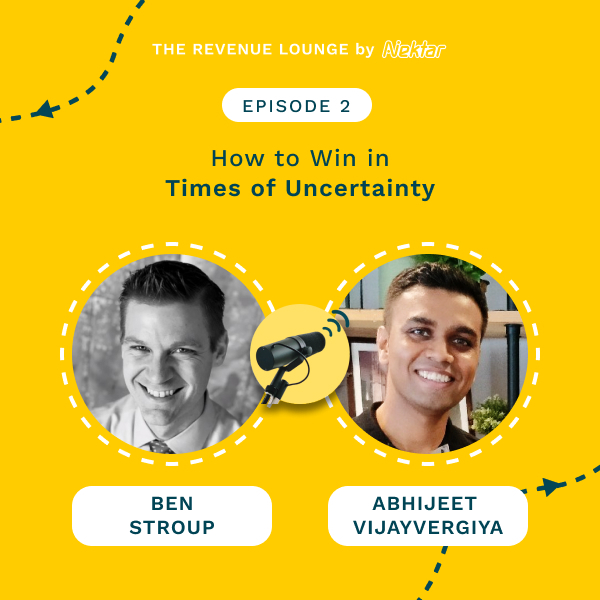
Ep #2: How to Win in Times of Uncertainty
Listen Now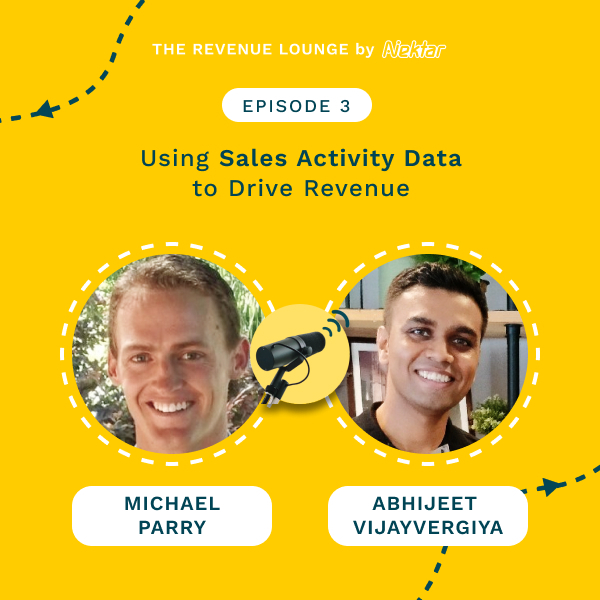
Ep #3: Using Activity Data to Drive Sales Productivity
Listen Now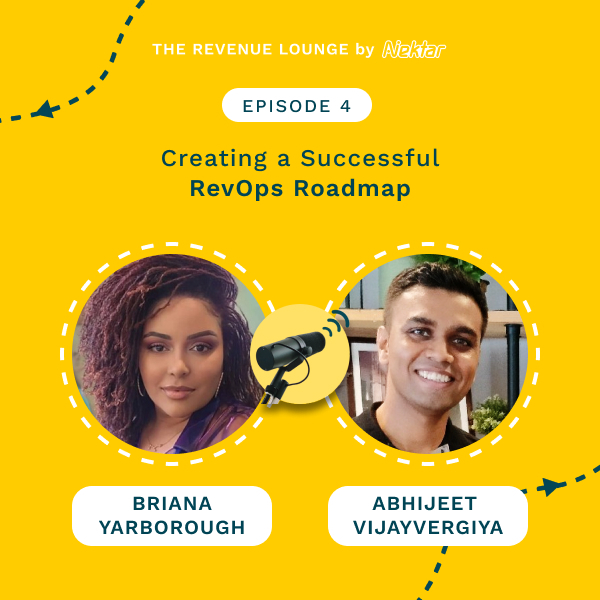
Ep #4: Creating a Successful RevOps Roadmap
Listen Now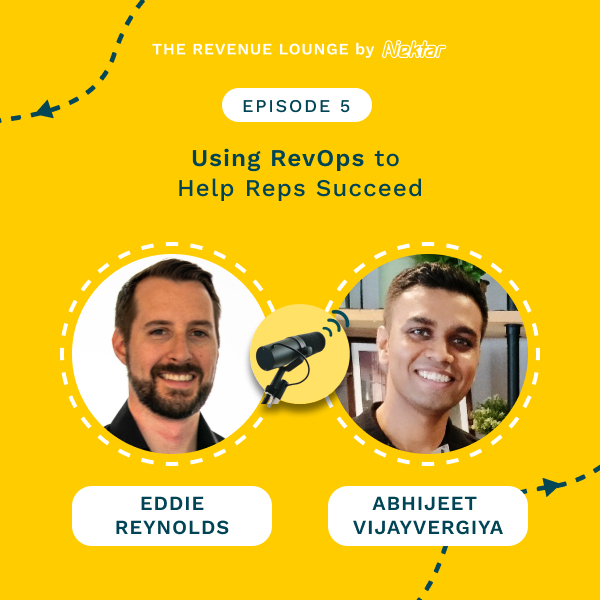
Ep #5: Using RevOps to Help Reps Succeed
Listen Now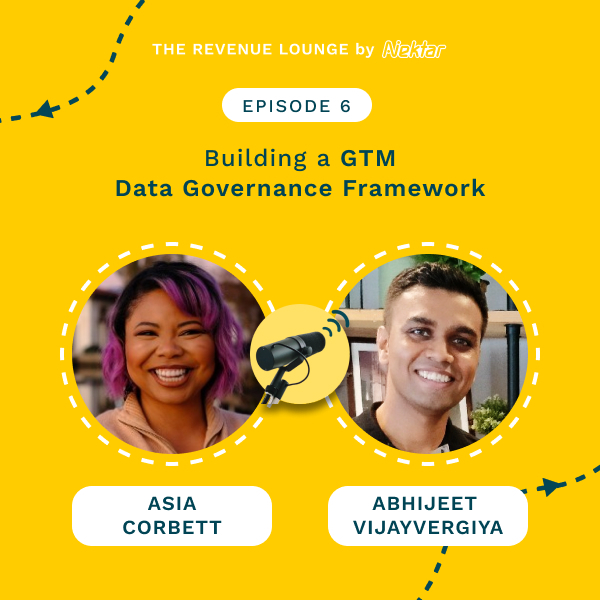
Ep #6: Building a GTM Data Governance Framework
Listen Now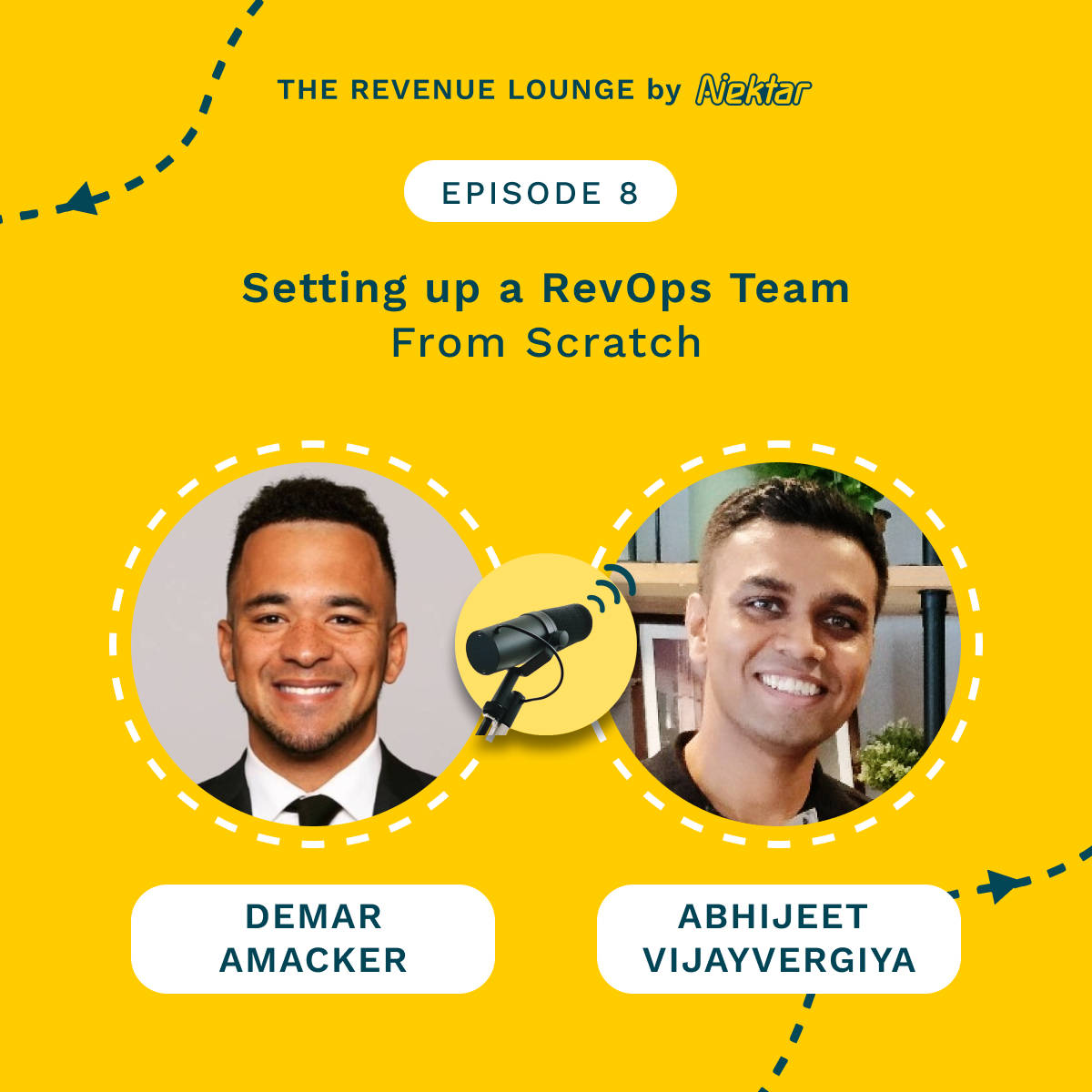
Ep #8: Setting Up a RevOps Team From Scratch
Listen Now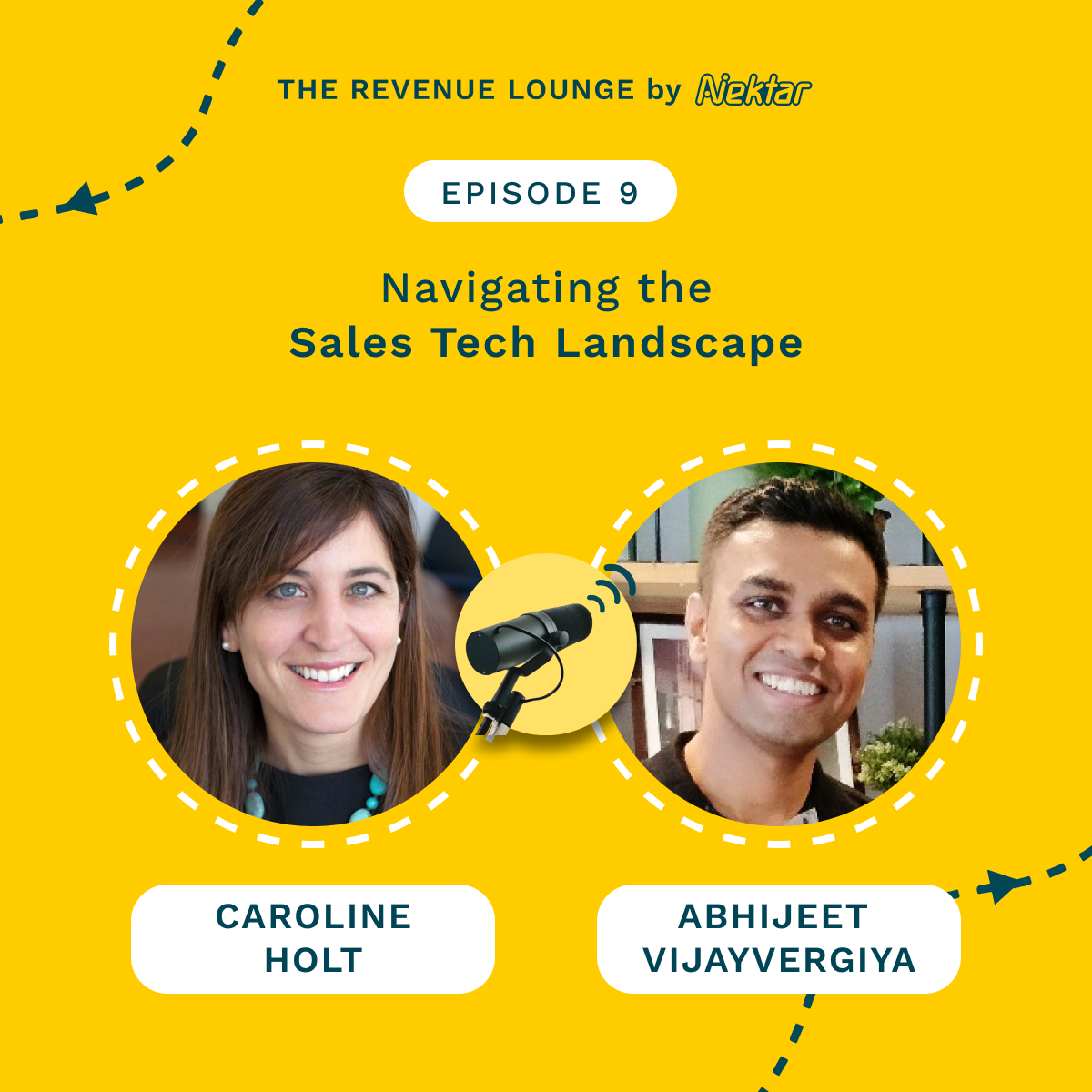
Ep #9: Navigating the Sales Tech Landscape
Listen Now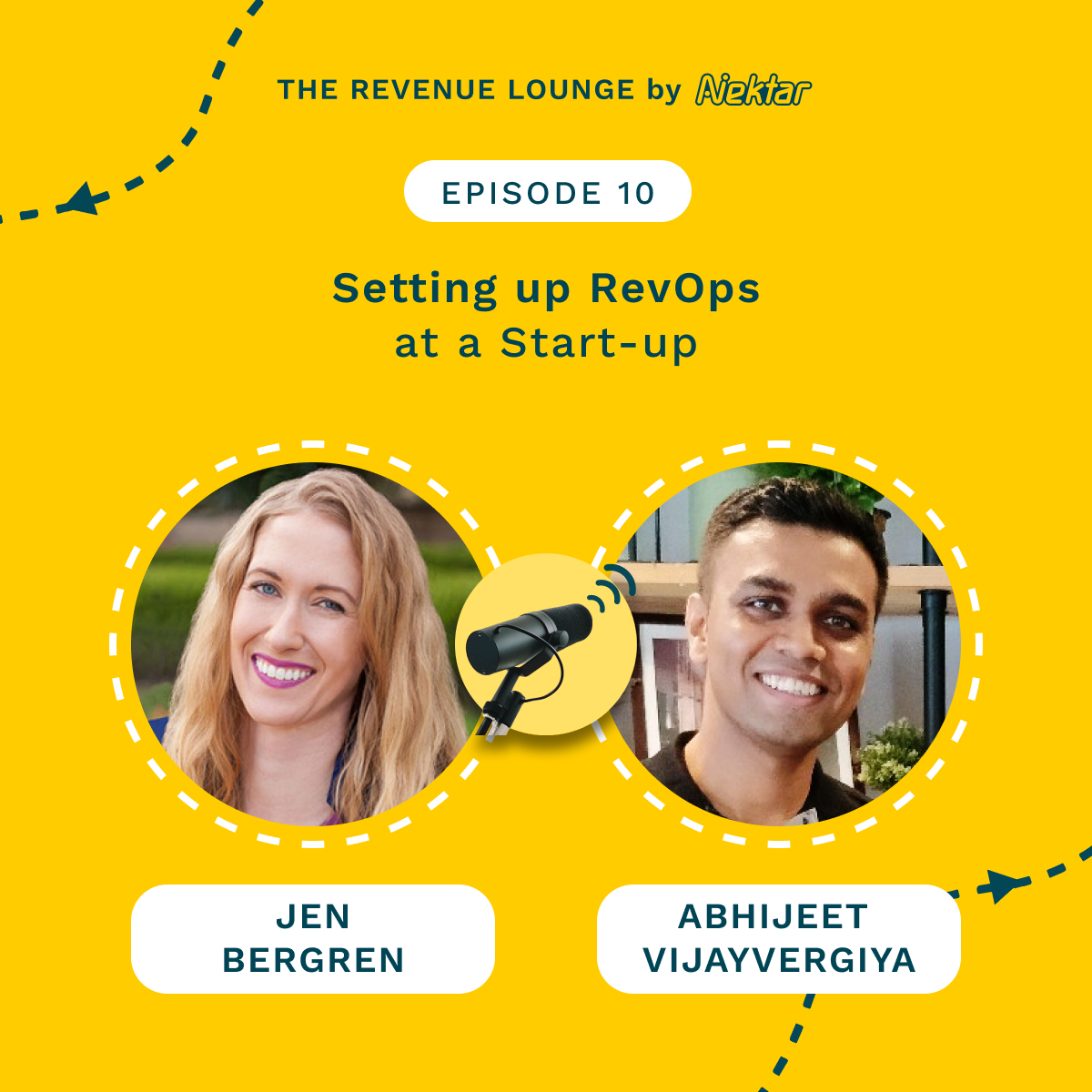
Ep #10: Setting Up RevOps at a Startup
Listen Now